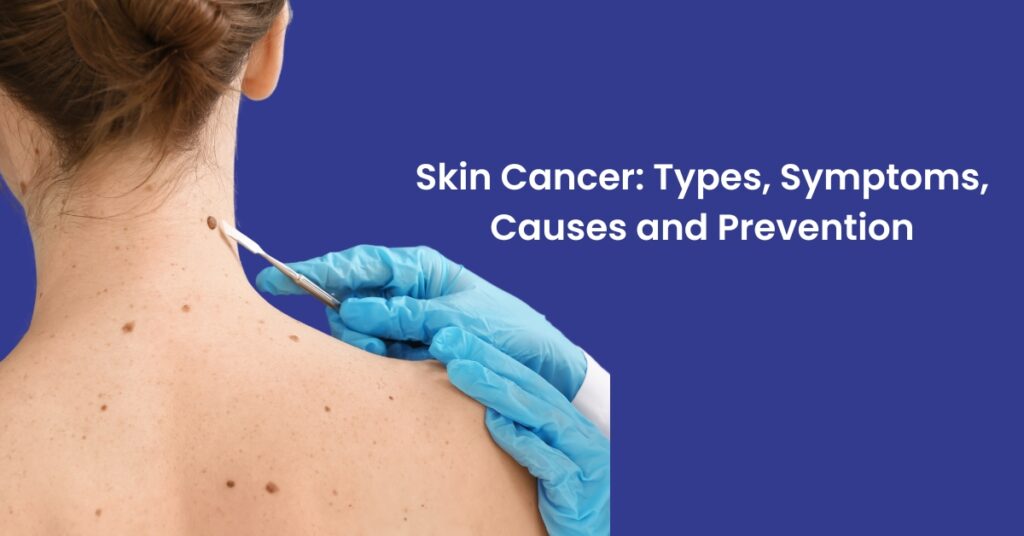Skin Cancer: Types, Symptoms, Causes and Prevention

Table of Contents
Skin cancer is the most common form of cancer worldwide, with statistics indicating that one in three cancers diagnosed globally is a skin cancer. Every year, there are over 3 million cases of non-melanoma skin cancer and 132,000 cases of melanoma reported globally. The incidence of skin cancer continues to rise, driven by factors such as increased UV exposure and aging populations. Let’s learn more about skin cancer.
What is Skin cancer?
Skin cancer arises when there is an uncontrolled growth of abnormal cells in the skin tissues. Normally, skin cells follow a systematic growth and death cycle, but exposure to UV light can disrupt this process, causing cells to proliferate abnormally. These abnormal cells can be either benign (noncancerous) or malignant (cancerous), with the latter having the potential to spread to other parts of the body if not treated promptly.
What are the different types of skin cancers?
- Melanoma skin cancers
Melanoma is a type of skin cancer that originates from melanocytes, the pigment-producing cells in the skin. It is considered the most serious form of skin cancer due to its ability to spread quickly to other parts of the body if not detected and treated early. Melanoma can develop from existing moles or appear as new growths on the skin.
- Non-melanoma skin cancers
Non-melanoma skin cancers are a group of skin cancers that do not originate from melanocytes, the pigment-producing cells in the skin. The two primary types of non-melanoma skin cancer are:
- Basal Cell Carcinoma (BCC): The most common type of skin cancer, BCC typically develops in the basal cells of the epidermis, the outermost layer of the skin. It often appears as a shiny, pearly bump or a flesh-colored patch, and it tends to grow slowly.
- Squamous Cell Carcinoma (SCC): SCC arises from the squamous cells in the outer layer of the skin. It can appear as a firm, red nodule, a flat lesion with a scaly crust, or a sore that does not heal. While SCC is less common than BCC, it has a higher risk of spreading to other parts of the body if left untreated.
What are the symptoms of skin cancer?
The key indicator of skin cancer is a noticeable change in the skin, such as:
- A new mole or a change in an existing mole (size, shape, color, or bleeding).
- Pearly or waxy bumps, typically on the face, ears, or neck.
- Flat, pink/red, or brown patches or bumps.
- Areas that resemble scars.
- Persistent sores that bleed or crust.
- Rough, scaly lesions that might itch or bleed.
Your skin matters—make an appointment at Pi Health Cancer Hospital for a comprehensive check-up!
The ABCDE rule helps in recognizing warning signs:
- Asymmetry: Irregular shape.
- Border: Blurry or irregular edges.
- Color: Multiple colors within a mole.
- Diameter: Larger than 6 millimeters.
- Evolution: Changes in size, shape, or color.
What are the causes of skin cancer?
The primary cause of skin cancer is UV light from the sun, which can damage the DNA in skin cells. Risk factors include:
- Excessive sun exposure or a history of sunburns.
- Fair skin, light-colored eyes, and light hair.
- Numerous or irregularly shaped moles.
- A family history of skin cancer.
- Weakened immune system, such as from organ transplants or certain medications.
- Use of tanning beds.
- Previous skin conditions treated with UV light therapy.
How can skin cancer be prevented?
Most skin cancers can be prevented by minimizing sun exposure and protecting the skin from UV rays. Key preventive strategies include:
- Using a broad-spectrum sunscreen with SPF 30 or higher.
- Wearing protective clothing, hats, and sunglasses.
- Avoiding the sun during peak hours (10 a.m. to 4 p.m.).
- Avoiding tanning beds.
- Checking medications for sun sensitivity.
Regular self-examinations of the skin for changes
Conclusion:
Skin cancer, despite its prevalence, is one of the most preventable cancers. By staying informed about its types, symptoms, causes, and preventive measures, you can significantly reduce your risk. Regular skin checks and dermatologist visits are crucial for early detection and successful treatment. Protect your skin, be aware of any changes, and seek medical advice promptly to improve outcomes.
References:
About Author
Dr. A. Venugopal
MD (General Medicine), DM (Medical Oncology), MRCP – SCE Medical Oncology (UK), ECMO (Switzerland).
Dr A. Venugopal is One of the best medical oncologist and Hemato Oncologist in hyderabad, currently serving as the Head of the Department and Senior Medical Oncologist, Hemato Oncologist at Pi Health Cancer Hospital in Gachibowli, Hyderabad. He brings over 15 years of extensive experience in the field of Oncology.

